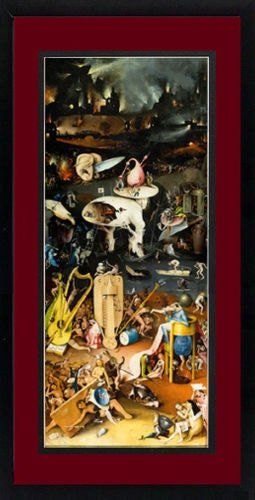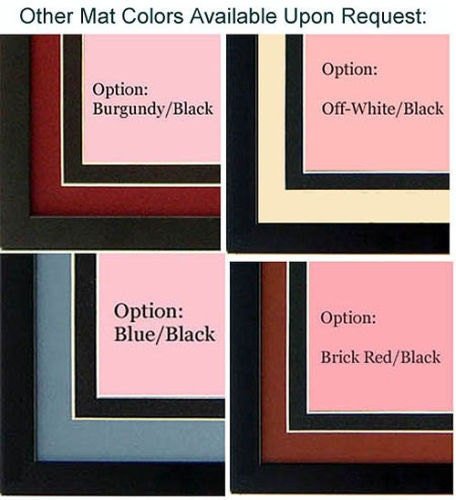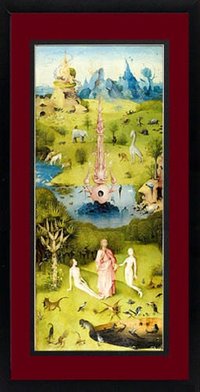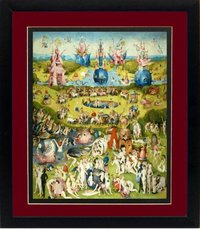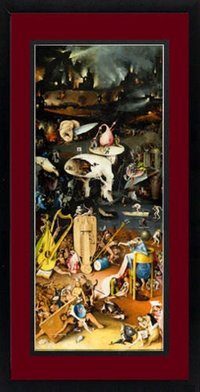LARGE Garden of Earthly Delights Art By Bosch 3 Framed Finest Quality Prints
$189.00
Premium Hieronymus Bosch set of 3 custom framed print. Triptych Garden of Earthly Delights
Includes 3 framed and double mated prints of the highest quality reproduction & detail.
Framed Size: 16x22, 22x22, 16x22 inches
Mat: Double Mat around print 1.5 inches in width
Molding: Solid Wood Maple With Flat Black Finish
Prints: Bonded & Dry-mounted Print on Foam Core. Perfectly flat and smooth finish
Glass is included, Comes Fully Assembled With Metal Wire Hooks. Ready For Your Wall
Mounting Method: Hot Vacuum Press(will never fold or fade)
The Garden of Earthly Delights is the modern title[1] given to a triptych painted by the Early Netherlandish master Hieronymus Bosch, housed in the Museo del Prado in Madrid since 1939. It dates from between 1490 and 1510, when Bosch was between about 40 and 60 years old,[2] and is his best-known[3] and most ambitious surviving work.[4]
The triptych is painted in oil on oak and is formed from a square middle panel flanked by two other oak rectangular wings that close over the center as shutters. The outer wings, when folded, show a grisaille painting of the earth during the biblical narrative of Creation. The three scenes of the inner triptych are probably (but not necessarily) intended to be read chronologically from left to right. The left panel depicts God presenting Eve to Adam, the central panel is a broad panorama of socially engaged nude figures, fantastical animals, oversized fruit and hybrid stone formations. The right panel is a hellscape and portrays the torments of damnation.
Art historians frequently interpret the painting as a didactic warning on the perils of life's temptations.[5] However, the intricacy of its symbolism, particularly that of the central panel, has led to a wide range of scholarly interpretations over the centuries.[6] Twentieth-century art historians are divided as to whether the triptych's central panel is a moral warning or a panorama of paradise lost. American writer Peter S. Beagle describes it as an "erotic derangement that turns us all into voyeurs, a place filled with the intoxicating air of perfect liberty".[7]
Includes 3 framed and double mated prints of the highest quality reproduction & detail.
Framed Size: 16x22, 22x22, 16x22 inches
Mat: Double Mat around print 1.5 inches in width
Molding: Solid Wood Maple With Flat Black Finish
Prints: Bonded & Dry-mounted Print on Foam Core. Perfectly flat and smooth finish
Glass is included, Comes Fully Assembled With Metal Wire Hooks. Ready For Your Wall
Mounting Method: Hot Vacuum Press(will never fold or fade)
The Garden of Earthly Delights is the modern title[1] given to a triptych painted by the Early Netherlandish master Hieronymus Bosch, housed in the Museo del Prado in Madrid since 1939. It dates from between 1490 and 1510, when Bosch was between about 40 and 60 years old,[2] and is his best-known[3] and most ambitious surviving work.[4]
The triptych is painted in oil on oak and is formed from a square middle panel flanked by two other oak rectangular wings that close over the center as shutters. The outer wings, when folded, show a grisaille painting of the earth during the biblical narrative of Creation. The three scenes of the inner triptych are probably (but not necessarily) intended to be read chronologically from left to right. The left panel depicts God presenting Eve to Adam, the central panel is a broad panorama of socially engaged nude figures, fantastical animals, oversized fruit and hybrid stone formations. The right panel is a hellscape and portrays the torments of damnation.
Art historians frequently interpret the painting as a didactic warning on the perils of life's temptations.[5] However, the intricacy of its symbolism, particularly that of the central panel, has led to a wide range of scholarly interpretations over the centuries.[6] Twentieth-century art historians are divided as to whether the triptych's central panel is a moral warning or a panorama of paradise lost. American writer Peter S. Beagle describes it as an "erotic derangement that turns us all into voyeurs, a place filled with the intoxicating air of perfect liberty".[7]



